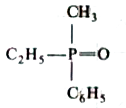Which one of the following complexes exhibit chirality?
[Cr(ox)3]3
cis-[PtCl2(en)]
cis-[RhCl2(NH3)4]+
mer−[Co(NO2)3(dien)]
The correct Answer is:A
To determine which of the following complexes exhibit chirality, we need to analyze the structures of each complex and see if they can form non-superimposable mirror images (optical isomers).
1. Understanding Chirality:
- Chirality refers to the property of a molecule that makes it non-superimposable on its mirror image. A chiral molecule typically has at least one chiral center, often a carbon atom bonded to four different substituents.
Hint: Remember that chirality is about the ability to form optical isomers.
2. Identifying the Complexes:
- Let's consider the complexes provided in the question. The first complex is CrOx (where OX represents oxalate, a bidentate ligand).
Hint: Identify the ligands and their bonding nature (monodentate vs bidentate).
3. Analyzing CrOx:
- The oxalate ligand (C2O4) is bidentate, meaning it can attach to the metal center at two points. In an octahedral geometry, if three oxalate ligands are coordinated to the chromium, the resulting structure can be asymmetric.
Hint: Draw the structure to visualize the arrangement of ligands around the metal center.
4. Checking for Optical Isomerism:
- Draw the mirror image of the CrOx complex. If the mirror image cannot be superimposed on the original structure, then the complex is chiral. In this case, the arrangement of the oxalate ligands creates a non-superimposable image.
Hint: Use a model or sketch to help visualize the superimposition of the original and mirror image.
5. Analyzing Other Complexes:
- Next, consider the structure of cisplatin (PtCl2(en)), where en is ethylenediamine (a bidentate ligand). The arrangement of ligands in cisplatin leads to a symmetric structure, which means the mirror image can be superimposed on the original.
Hint: Look for symmetry in the ligand arrangement to determine if a complex is chiral.
6. Considering Meridional and Facial Isomers:
- For complexes with meridional and facial isomers, such as those with three identical ligands, the meridional arrangement may also lead to non-superimposable images depending on the specific ligands used. However, in cases where all ligands are the same, they will not exhibit chirality.
Hint: Remember that identical ligands in symmetrical arrangements do not create chirality.
7. Conclusion:
- After analyzing the complexes, we find that the CrOx complex exhibits chirality due to its ability to form non-superimposable mirror images. Other complexes, like cisplatin, do not exhibit chirality.
Final Answer: The complex that exhibits chirality is CrOx.
- Chirality refers to the property of a molecule that makes it non-superimposable on its mirror image. A chiral molecule typically has at least one chiral center, often a carbon atom bonded to four different substituents.
- Let's consider the complexes provided in the question. The first complex is CrOx (where OX represents oxalate, a bidentate ligand).
- The oxalate ligand (C2O4) is bidentate, meaning it can attach to the metal center at two points. In an octahedral geometry, if three oxalate ligands are coordinated to the chromium, the resulting structure can be asymmetric.
- Draw the mirror image of the CrOx complex. If the mirror image cannot be superimposed on the original structure, then the complex is chiral. In this case, the arrangement of the oxalate ligands creates a non-superimposable image.
- Next, consider the structure of cisplatin (PtCl2(en)), where en is ethylenediamine (a bidentate ligand). The arrangement of ligands in cisplatin leads to a symmetric structure, which means the mirror image can be superimposed on the original.
- For complexes with meridional and facial isomers, such as those with three identical ligands, the meridional arrangement may also lead to non-superimposable images depending on the specific ligands used. However, in cases where all ligands are the same, they will not exhibit chirality.
- After analyzing the complexes, we find that the CrOx complex exhibits chirality due to its ability to form non-superimposable mirror images. Other complexes, like cisplatin, do not exhibit chirality.
Topper's Solved these Questions
- CO-ORDINATION COMPOUNDSBOOK - VK JAISWAL ENGLISHCHAPTER - CO-ORDINATION COMPOUNDSEXERCISE - SUBJECTIVE PROBLEMS
42 Videos
- CHEMICAL BONDING (BASIC)BOOK - VK JAISWAL ENGLISHCHAPTER - CHEMICAL BONDING (BASIC)EXERCISE - SUBJECTIVE PROBLEMS
54 Videos
- d-BLOCK ELEMENTSBOOK - VK JAISWAL ENGLISHCHAPTER - d-BLOCK ELEMENTSEXERCISE - ASSERTION-REASON TYPE QUESTIONS
32 Videos
Similar Questions
Knowledge Check
Which one of the following is chiral ?
A1, 1-Dibromo-1-chloropropaneB1,3-Dibromo-1-chloropropaneC1, 1-Dibromo-3-chloropropaneD1, 3-Dibromo-2-chloropropaneWhich of the following is chiral?
A B
B C
C D
D
Which of the following complex compound exhibits cis-trans isomerism?
View SolutionWhich one of the following elements exhibit maximum number of velence electrons ?
View SolutionWhich one of the following ions exhibits d-d transition and paramagnetism as well ?
View SolutionWhich one of the following does not exhibit variable oxidation states?
View SolutionWhich one of the following complexes shows optical isomerism ?
View SolutionWhich one of the following complexes will have six isomers ?
View Solution
